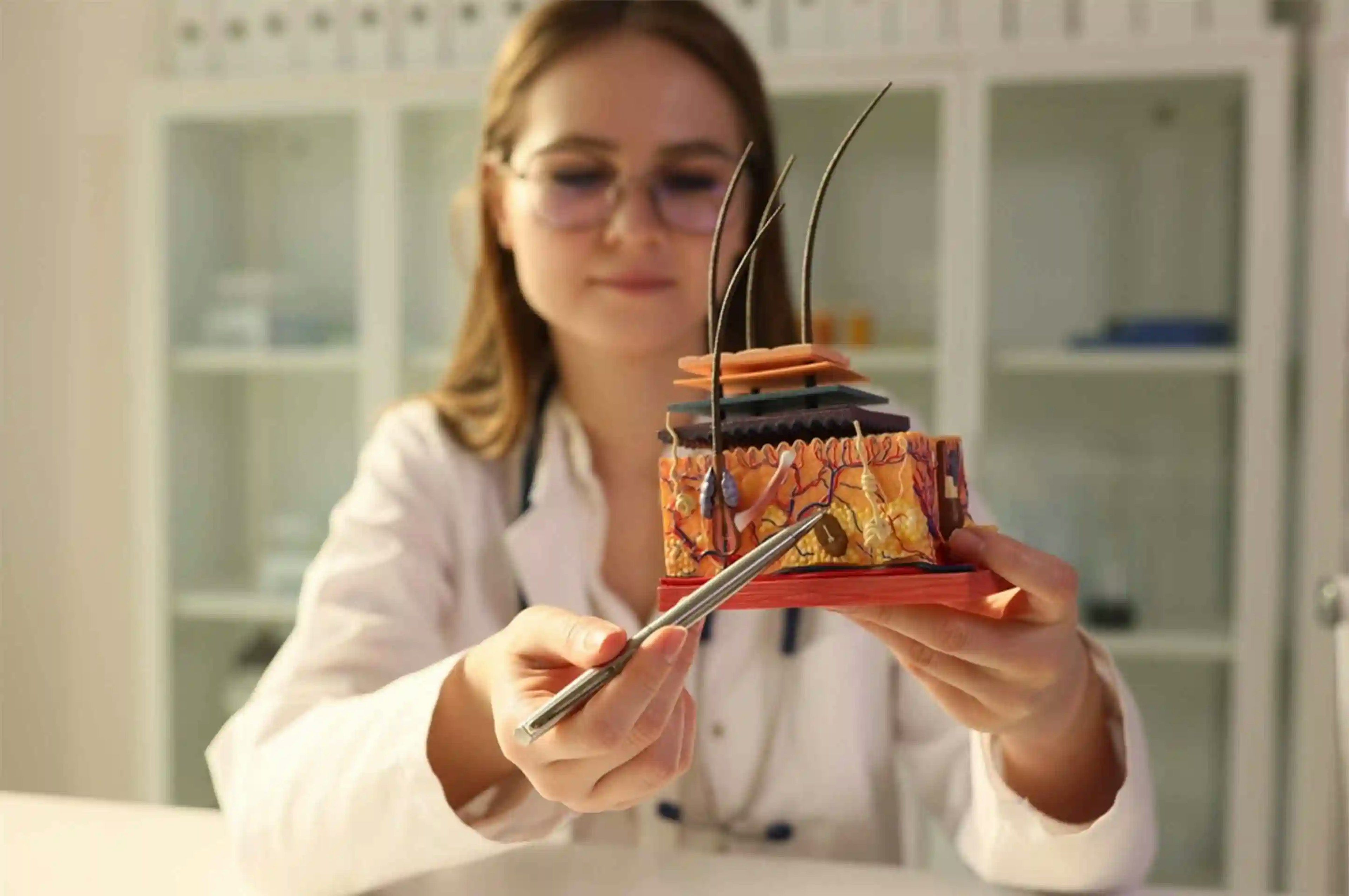
A Hair follicle is a tube-like structure (pore) that surrounds the root and strand of a hair. Hair follicles exist in the top two layers of your skin. You’re born with over 5 million hair follicles in your body and over one million hair follicles on your head. As you age, hair grows out of your hair follicles.
Your hair follicle is one of a few structures in your body that can stop functioning and begin functioning again (degenerate and regenerate). This process helps with hair growth on your body.
The function of a hair follicle is to grow your hair. In addition to promoting hair growth, your hair follicles also perform certain functions, such as Helping repair your skin after a wound or an injury.
Form new blood vessels (angiogenesis), Form new nervous system neuron cells (neurogenesis).
How does a hair follicle help with wound healing?
The cells in your hair follicles help your body heal after a wound. When your body receives an injury, the cells within your hair follicles are closest to the wound and quickly move to the site of the wound to start the healing process. Your hair follicle cells assist your body’s white blood cells in your immune system.
Hair grows in cycles within your hair follicle:
Anagen: The first phase of hair growth takes between two to seven years. Growth begins at the root (dermal papilla) in your hair follicle, which gives your hair blood supply and the nutrients it needs to grow. Your hair grows about 1 centimeter per month.
Catagen: The second phase of hair growth occurs when the hair transitions from a growing phase to a resting phase, which takes about two weeks. During this phase, your hair detaches from your blood supply.
Telogen: The final phase of hair growth is the inactive phase, where your hair sheds or falls out of your hair follicle. This phase takes up to four months.
ANATOMY
Where are hair follicles located?
Wherever you have hair on your body, you also have hair follicles. Hair follicles originate in the first and second layers of your skin (epidermis and dermis). Follicles holding your terminal hair, or the hair that grows on your scalp, eyelashes and eyebrows, extend into the first and second layer of your skin and sometimes into the third layer (subcutaneous tissue).
What does a hair follicle look like?
A hair follicle looks like a long tube that holds your hair. It’s in the shape of a cylinder with a rounded bottom in your skin. The top of the cylinder is an open hole, which is where your hair grows out. Your follicle is similar to a sock; your hair is your foot that goes into your sock.
What does a hair follicle look like when it’s pulled out?
You can’t pull out a hair follicle, as it’s the structure within your skin that holds your hair. If you pull out a strand of hair, you might notice a bulb or round ball (root) attached to the end of the hair strand. The root is surrounded by nerve fibers that let you feel when your hair moves or you touch your hair. Removing this root doesn’t mean your hair won’t grow back, because in most cases, it will.
What color are hair follicles?
While your hair color can change throughout your life, your hair follicle, which is part of your skin, is the same color as your natural skin tone. The color of your hair follicle doesn’t relate to the color of your hair.
How big is a hair follicle?
The size of each hair follicle in your body is different based on the size of the cells that make up the base of the structure. Hair follicles are microscopic and you can’t see them simply by looking at your skin.
What is a hair follicle made of?
Your hair follicle is made up of layers of cells within layers of your skin. These cells create a tube-like structure to hold your hair.
Now know about the hair strand structure: Your hair shaft is the part of your hair that can be seen above your scalp. It is made of a protein called keratin, compacted and fused together.
Keratin is the same material that nails, hoofs, feathers and claws are composed of.
Keratin is a remarkably strong protein, very resistant to wear and tear. It is held together by two kinds of bonds: disulphide bonds and hydrogen bonds.
Disulphide bonds are extremely durable. In fact, they are one of the strongest naturally occurring bonds in the world. When you perm it or relax your hair, these disulphide bonds are broken, and reset into a different configuration. This is what allows you to permanently change the shape of your hair.
Hydrogen bonds are weaker and more numerous than disulphide bonds. They help give your hair its flexibility. When you wet your hair, they are easily broken and can be temporarily reset with heat until they become wet again (either from water or humidity). This is what allows you to style your hair with hair dryers and tongs after washing.
Your hair shaft consists of three layers
The Cuticle
The cuticle is your hair’s protective layer, composed of overlapping cells — like fish scales or roof tiles, but facing downwards. A healthy cuticle is smooth and flat. This gives your hair shine and protects the inner layers from damage. It also minimises the movement of moisture in and out of the underlying cortex, thus maintaining your hair’s hydration balance and flexibility. However, chemical processes and weathering can lift the cuticle and disrupt this balance, causing your hair to become dry and brittle.
The Cortex
The cortex forms the main bulk and pigment (colour) of your hair. It consists of long keratin filaments, which are held together by disulphide and hydrogen bonds. The health of your cortex depends largely on the integrity of the cuticle protecting it.
The Medulla
The medulla, only present in thicker Hair types , is the innermost layer of your hair. It consists of a soft, thin core of transparent cells and air spaces.



